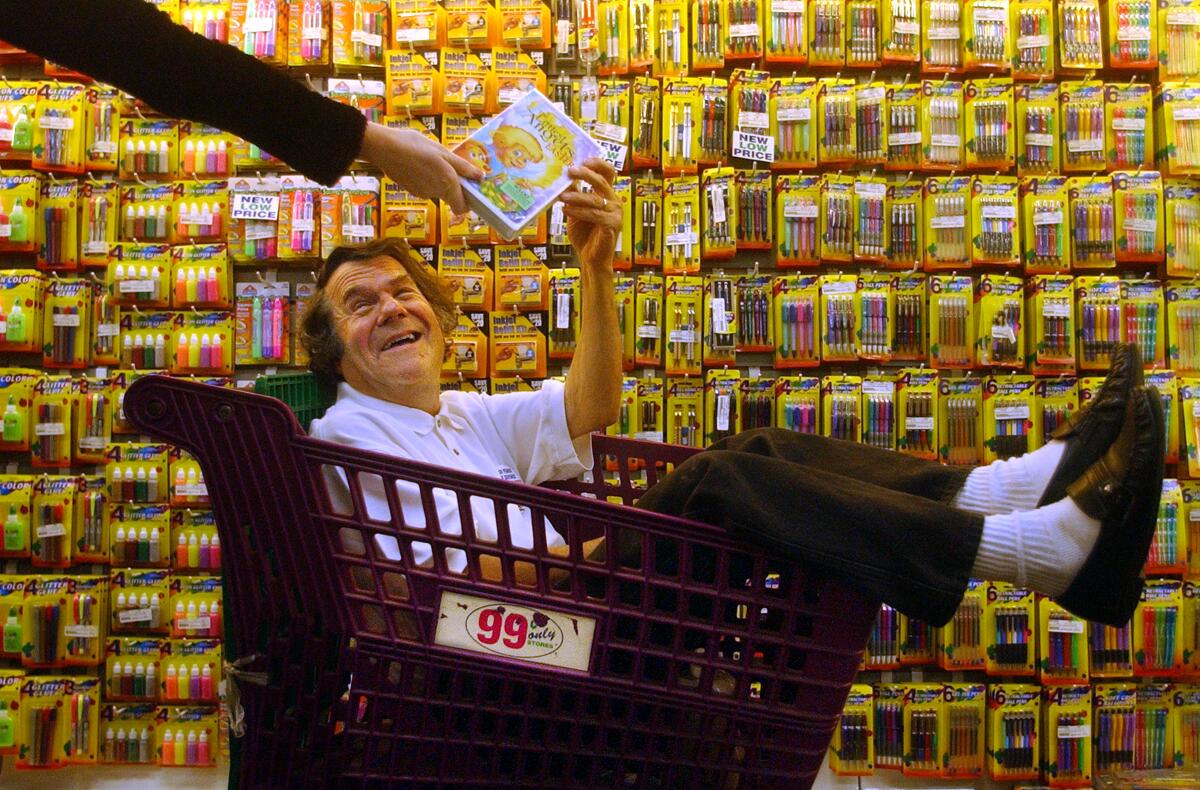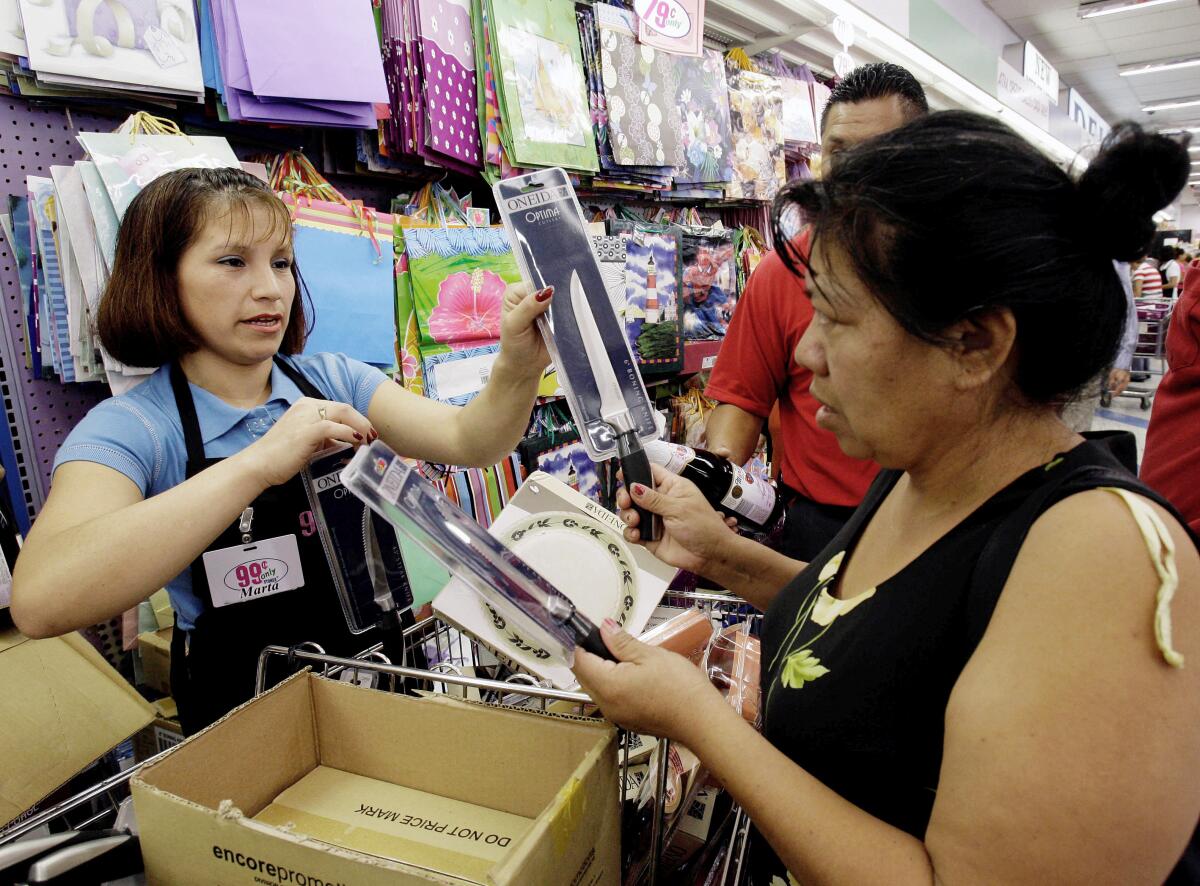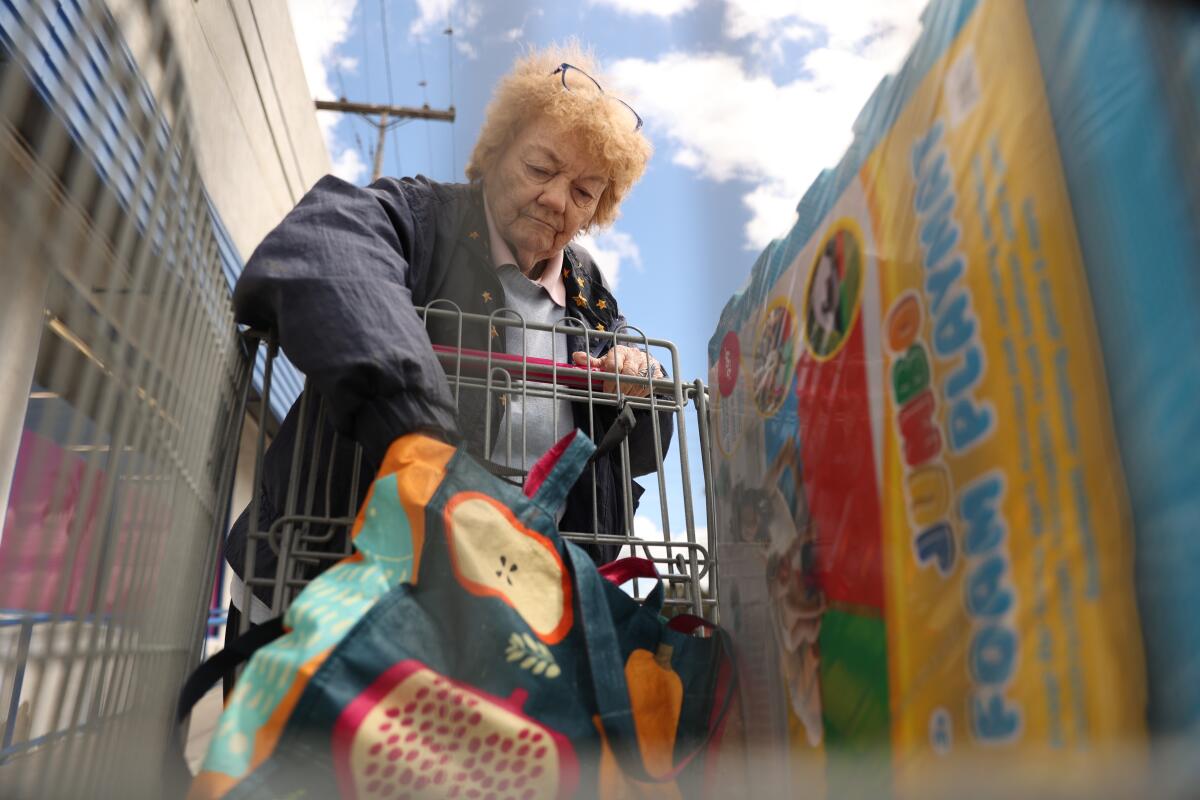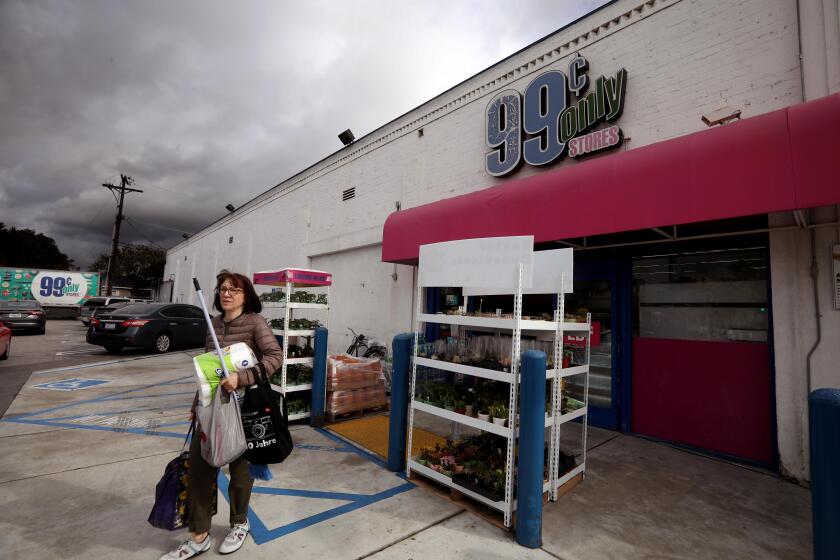99 Cents Only was an L.A. icon. Inside the fall of the popular chain

- Share via
It was Friday the 13th when the first 99 Cents Only store opened in 1982 on La Tijera Boulevard.
To commemorate the grand opening, founder David Gold sold television sets for 99 cents to the first 13 customers. He had developed his affinity for the price point while working at a liquor shop at Grand Central Market downtown, when he would put closeout bottles of wine on a table and mark them down to 99 cents.
The City of Commerce deep-discount retailer, for years one of the few true “dollar” stores, calls it quits after more than four decades.
After that first August morning, the everyday deals at 99 Cents Only weren’t television-set levels of spectacular, but the bargains were steep and the extreme discounter became an essential stop within the community, son Howard Gold recalled in an interview last week.
“We were jam-packed from the beginning,” said Howard, who helped set up and manage the fledgling store as a 22-year-old, stocking it with canned and paper goods, candy, mugs, glassware, hair products and cosmetics that his father, who died in 2013, bought in enormous quantities. “It was amazing values — people could go and get like three bags of stuff and spend $9.”
Within two years, the family — all four Gold children eventually worked for 99 Cents Only in some capacity — had opened two more locations. By 1991, there were two dozen.

Business boomed over the next couple of decades. 99 Cents Only had grown to 289 stores in California, Texas, Arizona and Nevada by the time it agreed to be sold in 2011 to Los Angeles private equity firm Ares Management and the Canada Pension Plan Investment Board.
Now, all 371 stores are liquidating after the City of Commerce company abruptly announced last week that it was going out of business. It’s a stunning fall for the beloved chain, whose stores are primarily located in urban areas and underserved communities, many of which lack close access to traditional grocery stores.
What happened? Company executives and industry analysts blamed a series of factors, including the COVID-19 pandemic, escalating theft and crime, competition, big increases in operating costs stemming from high inflation and the expense of servicing its debt. The company also cited significant minimum-wage jumps, particularly in California, where 265 of its stores are located.
“The last several years have been extremely difficult,” Chief Restructuring Officer Christopher J. Wells said in a bankruptcy declaration filed Monday. “The company had no choice but to pass on to its customers some of the resulting costs, in the form of higher prices, which was met by significant customer resistance and reduced customer traffic.”

A representative for 99 Cents Only Stores did not respond to requests for comment.
The privately held company, which has 10,874 employees, recorded operating losses of $30.8 million in 2022 and nearly $60 million in the first three quarters of 2023.
Since the beginning of the year, 99 Cents Only executives “exhaustively pursued” options in an attempt to save the flailing discounter, Wells said. An investment bank hired by the company contacted 32 prospective buyers, and the chain reached out to existing shareholders and third parties about potentially financing a restructuring that would enable it to continue operating.
But none of those efforts panned out. Cash flow in the first quarter “continued to rapidly deteriorate,” Wells said, “and time was not on the company’s side.” By March, a “substantial and increasing” number of vendors had tightened trade terms and shifted to cash on demand, and several landlords sent pay-or-quit default notices as the company struggled to make rent on time.
When 99 Cents Only Stores filed for Chapter 11 bankruptcy protection last weekend, it reported owing nearly $60 million to its 30 largest unsecured creditors, including Frito-Lay, a Coca-Cola bottler and Colgate-Palmolive. It also reported carrying $457 million of debt in loans and lines of credit.
Going-out-of-business sales began Friday and are expected to end April 19, with prices storewide slashed by up to 30%.
The rise of an L.A. retail giant
From the start, 99 Cents Only stood out from other dollar stores thanks to David Gold’s buying prowess: his eye for spotting quality, brand-name products that customers of all income levels would want, coupled with his willingness to purchase them from suppliers in vast amounts.
“When I put a 99-cent sign on anything, it was gone in no time,” he said in a 2003 Los Angeles Times article. “I realized it was a magic number. I thought, wouldn’t it be fun to have a store where everything was good quality and everything was 99 cents?”
He was 50 when he opened the first 99 Cents Only store and handled nearly all of the company’s buying for years, Howard said, with the rest of the family managing operations and logistics.
“My dad in a lot of ways was very, very bold,” Howard, 64, said. “He wasn’t a person who wrote out a business plan — he just did things.”
In the early 1980s, dollar stores were seen as shabby dumping grounds for undesirable products, but the founder was proud of what he sold and wanted 99 Cents Only to “look clean and well-organized even though they were closeout stores,” Howard said.
“My dad really loved the merchandise,” daughter Karen Schiffer said in his 2013 Times obituary; despite making millions from 99 Cents Only, Gold lived modestly and died in his Mid-Wilshire home at 80. “He would come home at the end of the day when we were younger and say, ‘Look at this beautiful shampoo.’ He would say, ‘We have 50 truckloads of this Kleenex coming in.’”
“When I put a 99-cent sign on anything, it was gone in no time.”
— David Gold
One time, just before the 1984 Olympic Games in Los Angeles, the retailer purchased 500,000 authentic Olympic souvenir hats for 37 cents each. It priced them at 99 cents apiece, when other shops listed them at $8. The three 99 Cents Only stores were soon inundated with customers.
“We had to hire security guards to hold people back,” Thomas Hale, the company’s vice president at the time, told The Times in 1991. “Before I could take vanloads of the hats into the store, they were sold; they never made it to the counter. I had never seen anything like it.”

Gold stayed true to the low price point and leaned heavily into the theme.
One advertisement congratulated the “Dodgers on Losing 99 Games.” Another wished television personality Joan Rivers “Happy 99th Facelift.” He opened the stores from 9 a.m. to 9 p.m., “nine days a week.”
Those of us in the fellowship of frugality know that California’s booms inevitably end in bust. That’s what makes the end of the 99 Cents Only empire so distressing.
In 1996, when it had about four dozen stores, 99 Cents Only went public on the New York Stock Exchange at $14.50 a share. Just over a year later, it was trading around $32.
Gold made the Forbes 400 list in 2002, with 142 stores in his fast-growing chain, no corporate debt and a personal fortune estimated at $650 million. He was, according to some calculations, the 37th richest man in Los Angeles.
Still, he continued to hold open-house days, inviting wholesalers and suppliers to show off their wares over coffee and bagels that he provided.
“It’s almost impossible to describe the crowd that lines the narrow hallway on these days,” the 2003 Times article said. “They come to Gold’s City of Commerce headquarters hoping to sell everything from clothing to kites to hand-painted pottery, paper and housewares products.”
New owners and a big debt load
After 15 years as a publicly traded company, 99 Cents Only was the subject of a bidding war by two Los Angeles investment firms.
Leonard Green & Partners offered to take the retailer private, in a deal that valued the company at $1.3 billion, but was topped by Ares and its pension fund partner. It was a period when investors were eyeing dollar stores that had grown in popularity during the Great Recession.
“It was a difficult decision; we at the time weren’t crazy about being public,” Howard recalled last week. “We felt like it put us in a position where we had to continually have smooth growth of numbers, which wasn’t necessarily that conducive to our business. We didn’t want to have to deliver the kind of numbers that Wall Street demanded.”
The family management team remained for about a year after the deal was done, departing in 2013. Before that, David Gold’s son-in-law Eric Schiffer was chief executive, son Jeff was chief administrative officer, and Howard worked as executive vice president of special projects.
The deal — which valued 99 Cents Only Stores at $1.6 billion — saddled the company with a debt load that turned a “conservative balance sheet” into a “highly leveraged capital structure,” Standard & Poor’s Rating Services said in a report.
The company struggled with debt for years. Its financial position continued to erode even after it sold a City of Commerce distribution center last year for $190 million, then leased it back, to raise capital, according to S&P Global Ratings.
Howard declined to discuss the company’s business after the family’s exit, saying only that the closures were “sad on so many levels.”
Breaking the 99-cent barrier in 2008
Well before the pandemic and the latest surge in inflation, 99 Cents Only drifted from its original promise to keep all items under one dollar.
In 2008, the company broke the 99-cent barrier for the first time amid fast-rising inflation, soaring food and fuel prices and a higher minimum wage — many of the same factors that ultimately felled it. The price change was rolled out gradually but accelerated in recent years.
In his bankruptcy declaration Monday, Wells said the percentage of merchandise priced at “99.99 cents or less” decreased from nearly 65% in 2020 to less than 50% last year.
Sujeet Naik, an analyst for Coresight Research, noted that consumers have been looking for deals to alleviate record inflation. As a deep discounter, 99 Cents Only would seem like an obvious money-saving solution — except the company was forced to raise prices as it, too, contended with inflationary pressures.
And with 99 Cents Only in the company name, the widening discrepancy between its longtime marketing hook and what was actually on the price tags became glaring to budget-conscious customers.
“Their business model relied heavily on that psychological pricing of every item being 99 cents only,” Naik said.
Making matters worse, he added, inflation also hit the company’s operational costs, such as rent, labor and transportation, and it faced competition from larger rivals with greater purchasing power.
Even some of its giant competitors have struggled of late.
Last month Chesapeake, Va.-based Dollar Tree announced the closure of nearly 1,000 Family Dollar stores over the next few years. The company, which operates hundreds of Dollar Tree and Family Dollar stores in California, said product costs have risen.
Although 99 Cents Only wasn’t able to secure a buyer in its final few months, one local businessman says he is trying to save the company.
Mark Miller, founder and president of discounter Pic ‘N’ Save Bargains, said he had put together an investment group that includes former 99 Cents Only executives to make a bid for all 143 stores in Southern California through the bankruptcy process.
“For the past 10 years, they didn’t have anybody running the company that had any understanding of what the business was about. They drifted away from what David Gold started,” he told The Times on Tuesday, adding that his vision for the stores would feature a mix of consistent inventory with surprise bargains he likened to a “treasure hunt.”
A spokesperson for Ares declined to comment.
The closure of the stores will leave a number of large vacant properties in prime locations around the region. Hilco Real Estate is managing the sale of the company’s real estate assets, which are owned or leased.
At a 99 Cents Only store in Glendale on Friday, a day after the company announced it was winding down its business, drivers jammed into the full parking lot, many pulling over to double-park wherever they could find space.
Inside the store, the checkout lines snaked through and around the aisles, many of the shelves bare of merchandise.
Although there were 2-liter bottles of grapeseed oil for $8, potted succulents for $5 and stuffed animals and jump ropes for $4, plenty of items were marked at less than a dollar: cans of sweet corn and sliced carrots, packages of spicy ramen, liter bottles of electrolyte drinks and three-packs of sponges.
“We’re not going to find the same prices at any other store,” shopper Rosemary Loera, 46, said as she left with a cart full of laundry detergent, cleaning solution, pet food, grapes, pears and disposable plates. She spent more than $100 at the store, which she visits weekly.
Antonio D. Charity, an actor from Burbank, arrived after hearing that the chain was shutting down. He has been a 99 Cents Only shopper for nearly 20 years, often showing up without a shopping list just to peruse the aisles and buy based on the deals of the day.
“I know to come here after Thanksgiving, because a lot of products they didn’t sell at the grocery stores, they’ll wind up here. I know to come after Valentine’s; there’ll be a lot of candy on the shelves,” the 51-year-old said as he scooped up 10 boxes of diet tea. “I’m gonna miss it.”
More to Read
Sign up for This Evening's Big Stories
Catch up on the day with the 7 biggest L.A. Times stories in your inbox every weekday evening.
You may occasionally receive promotional content from the Los Angeles Times.














